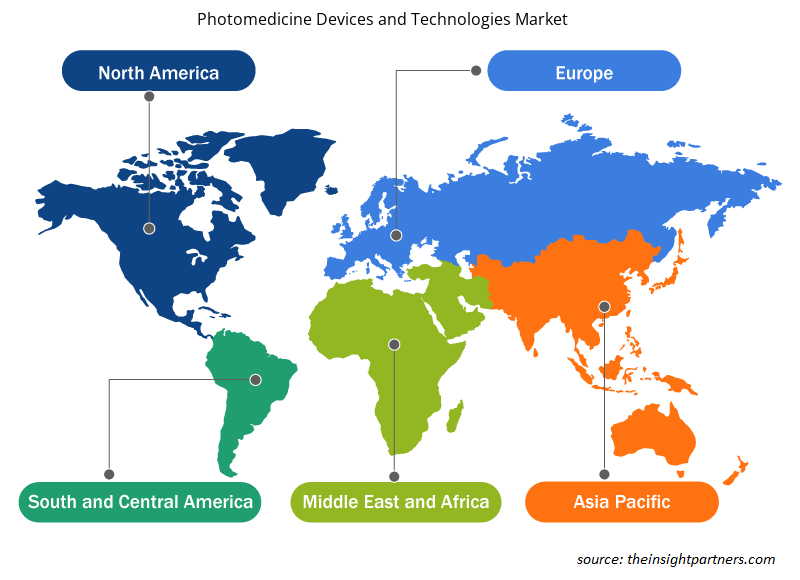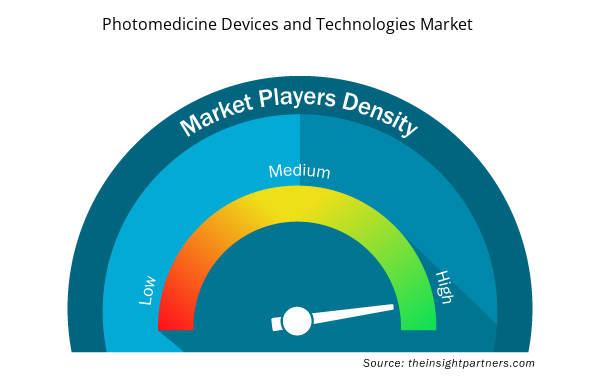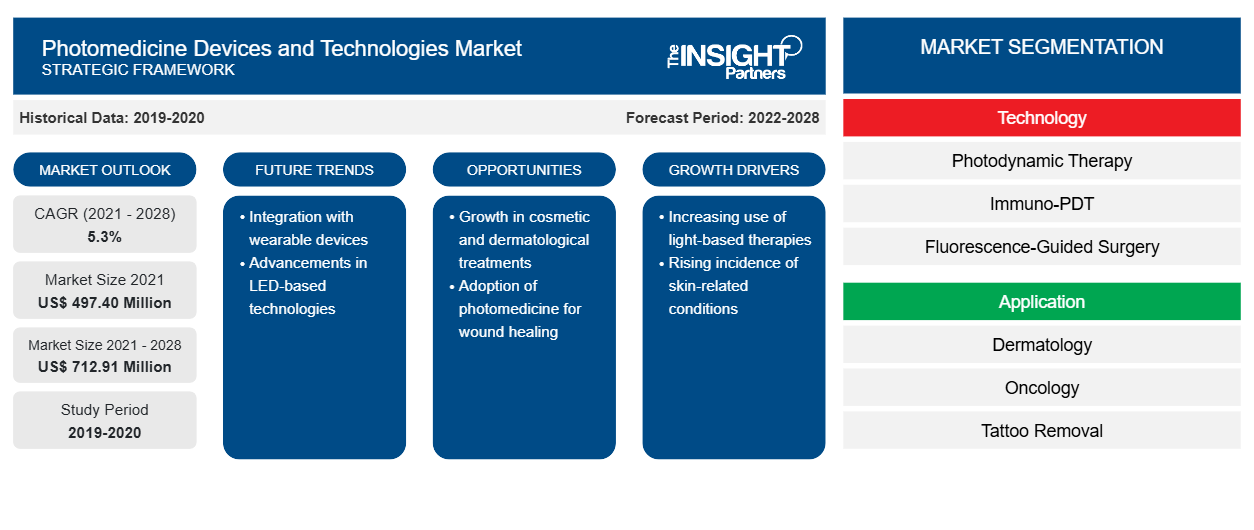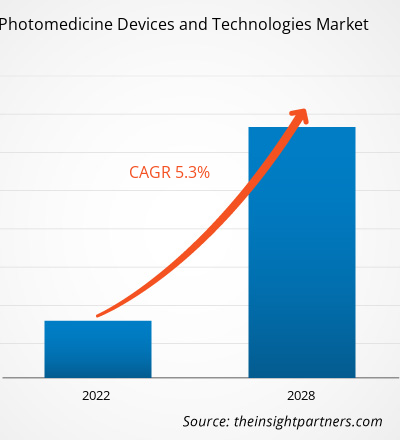光医疗设备和技术市场预计将从 2021 年的 4.974 亿美元增至 2028 年的 7.1291 亿美元;预计 2021 年至 2028 年的复合年增长率为 5.3%。
光医学是一门医学学科,利用光生物学和光来治疗疾病和其他医学状况。这种治疗使用激光、全光谱光、二向色灯、多色偏振光、发光二极管和荧光灯,使人们暴露在特定波长的光下。光医学是治疗多种疾病的一种新选择,其效果优于诊断和检测疾病的旧技术。光医学的广泛适用性以及对微创和非侵入性疗法的需求增加等因素正在推动光医学设备和技术市场的增长。然而,严格的光医学技术监管框架阻碍了市场的增长。
市场洞察
微创和非侵入性治疗需求增长推动光医疗设备和技术市场增长
近年来,微创医疗手术越来越受欢迎,因为微创手术切口小、患者恢复更快、患者不适感更少。此外,光医学手术还具有疼痛更少、对肌肉、神经、组织和器官的创伤更小、出血和疤痕更少、对组织损伤最小等优点。根据美国整形外科医师协会的数据,2020 年,美国进行了超过 1560 万例微创美容手术。 2020 年共进行了 13,281,235 例微创美容手术。在排名前五的美容微创手术中,强脉冲光 (IPL) 治疗已取代激光脱毛治疗,2020 年共进行了超过 827,000 例 IPL 治疗。根据国际美容整形外科学会 (ISAPS) 发布的全球报告,全球进行的美容和美容手术数量从 2014 年的 20,236,901 例增加到 2018 年的 23,266,374 例。
定制此报告以满足您的需求
您可以免费定制任何报告,包括本报告的部分内容、国家级分析、Excel 数据包,以及为初创企业和大学提供优惠和折扣
- 获取此报告的关键市场趋势。这个免费样品将包括数据分析,从市场趋势到估计和预测。
基于技术的见解
根据技术,光医疗设备和技术市场细分为光动力疗法 (PDT)、免疫 PDT (光免疫疗法)、荧光引导手术、光动力诊断、光生物调节 (激光灯) 和其他技术。光动力疗法领域在 2021 年占据了最大的市场份额,预计在预测期内将实现最高的复合年增长率。
基于应用的洞察
根据应用,光医学设备和技术市场细分为美学和皮肤科、肿瘤科、眼科、神经科、疼痛管理、伤口愈合和其他应用。美学和皮肤科细分市场进一步细分为脱毛、纹身去除、皮肤重修和其他应用。美学和皮肤科细分市场在 2021 年占据了最大的市场份额,预计该细分市场在预测期内将实现最高的复合年增长率。
在光医学设备和技术市场运营的各公司正在采用产品发布、并购、合作、产品创新和产品组合扩展等策略,以扩大其全球影响力、维护品牌名称并满足最终用户日益增长的需求。
光医学设备与技术
光医学设备和技术市场区域洞察
Insight Partners 的分析师已详尽解释了预测期内影响光医疗设备和技术市场的区域趋势和因素。本节还讨论了北美、欧洲、亚太地区、中东和非洲以及南美和中美洲的光医疗设备和技术市场细分和地理位置。

- 获取光医疗设备和技术市场的区域特定数据
光医学设备和技术市场报告范围
| 报告属性 | 细节 |
|---|---|
| 2021 年市场规模 | 4.974亿美元 |
| 2028 年市场规模 | 7.1291亿美元 |
| 全球复合年增长率(2021 - 2028) | 5.3% |
| 史料 | 2019-2020 |
| 预测期 | 2022-2028 |
| 涵盖的领域 | 按技术分类
|
| 覆盖地区和国家 | 北美
|
| 市场领导者和主要公司简介 |
|
光医疗设备和技术市场参与者密度:了解其对业务动态的影响
光医疗设备和技术市场正在快速增长,这得益于终端用户需求的不断增长,而这些需求又源于消费者偏好的不断变化、技术进步以及对产品优势的认识不断提高等因素。随着需求的增加,企业正在扩大其产品范围,进行创新以满足消费者的需求,并利用新兴趋势,从而进一步推动市场增长。
市场参与者密度是指在特定市场或行业内运营的企业或公司的分布情况。它表明在给定市场空间中,相对于其规模或总市场价值,有多少竞争对手(市场参与者)存在。
在光医疗设备和技术市场运营的主要公司有:
- 阿尔玛激光
- 博雅有限公司
- 生物技术公司
- 科医人
- 宽泰医疗
免责声明:上面列出的公司没有按照任何特定顺序排列。

- 了解光医疗设备和技术市场的主要参与者概况
光医疗设备和技术市场 – 按技术分类
- 光动力疗法 (PDT)
- 免疫光动力治疗 (光免疫疗法)
- 荧光引导手术
- 光动力诊断
- 光生物调节(激光灯)
- 其他技术
光医疗设备和技术市场 – 按应用划分
- 美学与皮肤科
- 脱毛
- 去除纹身
- 皮肤重塑
- 其他应用
- 肿瘤学
- 眼科
- 神经病学
- 疼痛管理
- 伤口愈合
- 其他应用
光医疗设备和技术市场 – 按地区划分
- 北美
- 我们
- 加拿大
- 墨西哥
- 欧洲
- 法国
- 德国
- 意大利
- 英国
- 西班牙
- 欧洲其他地区
- 亚太地区 (APAC)
- 中国
- 印度
- 韩国
- 日本
- 澳大利亚
- 亚太其他地区
- 中东和非洲 (MEA)
- 南非
- 沙特阿拉伯
- 阿联酋
- 中东和非洲其他地区
- 南美洲 (SAM)
- 巴西
- 阿根廷
- 南美洲和中美洲其他地区
公司简介
- 阿尔玛激光
- 博雅有限公司
- 生物技术公司
- 科医人
- 宽泰医疗
- THOR光医学有限公司
- 威瑞克斯公司
- 坎德拉医疗
- 荷兰皇家飞利浦公司
- Iridex 公司
- 历史分析(2 年)、基准年、预测(7 年)及复合年增长率
- PEST 和 SWOT 分析
- 市场规模价值/数量 - 全球、区域、国家
- 行业和竞争格局
- Excel 数据集



Report Coverage
Revenue forecast, Company Analysis, Industry landscape, Growth factors, and Trends

Segment Covered
This text is related
to segments covered.

Regional Scope
North America, Europe, Asia Pacific, Middle East & Africa, South & Central America

Country Scope
This text is related
to country scope.
常见问题
Global photomedicine devices and technologies market is segmented by region into North America, Europe, Asia Pacific, Middle East & Africa and South & Central America. In North America, the U.S. is the largest market for photomedicine devices and technologies. The US is estimated to hold the largest share in the photomedicine devices and technologies market during the forecast period. Whereas, Asia Pacific is the fastest growing region during the forecast period with highest CAGR rate of 6.1%. The growth of Asia Pacific photomedicine devices and technologies market is owing to, increasing burden of chronic diseases such as cancer, rise in demand for minimally invasive surgical procedures and growing adoption of photomedicine.
The photomedicine devices and technologies market majorly consists of the players such as Alma Lasers, Beurer GmbH., Biolitec AG, Lumenis, Quantel Medical, THOR Photomedicine Ltd, Verilux Inc, Candela Medical, KONINKLIJKE PHILIPS N.V., and Iridex Corporation, among others
The photodynamic therapy segment dominated the global photomedicine devices and technologies market and held the largest revenue share of 24.82% in 2021.
The aesthetics and dermatology segment dominated the global photomedicine devices and technologies market and accounted for the largest revenue share of 27.72% in 2021.
Photomedicine is a discipline of medicine that uses photobiology and light to cure diseases and other medical conditions. Photomedicine is the use of lasers, full-spectrum light, dichroic lamps, polychromatic polarized light, light-emitting diodes, and fluorescent lamps to expose people to specific wavelengths of light. Photomedicine is a new therapy option for a variety of disorders that has outperformed the old technique of diagnosing and detecting a condition.
Key factors that are driving the growth of this market are wider applicability of photomedicine and rise in demand for minimally invasive and non-invasive therapies.
Trends and growth analysis reports related to Life Sciences : READ MORE..
The List of Companies - Photomedicine Devices and Technologies Market
- Alma Lasers
- Beurer GmbH
- Biolitec AG
- Lumenis
- Quantel Medical
- THOR Photomedicine Ltd
- Verilux Inc
- Candela Medical
- KONINKLIJKE PHILIPS N.V
- Iridex Corporation
The Insight Partners performs research in 4 major stages: Data Collection & Secondary Research, Primary Research, Data Analysis and Data Triangulation & Final Review.
- Data Collection and Secondary Research:
As a market research and consulting firm operating from a decade, we have published and advised several client across the globe. First step for any study will start with an assessment of currently available data and insights from existing reports. Further, historical and current market information is collected from Investor Presentations, Annual Reports, SEC Filings, etc., and other information related to company’s performance and market positioning are gathered from Paid Databases (Factiva, Hoovers, and Reuters) and various other publications available in public domain.
Several associations trade associates, technical forums, institutes, societies and organization are accessed to gain technical as well as market related insights through their publications such as research papers, blogs and press releases related to the studies are referred to get cues about the market. Further, white papers, journals, magazines, and other news articles published in last 3 years are scrutinized and analyzed to understand the current market trends.
- Primary Research:
The primarily interview analysis comprise of data obtained from industry participants interview and answers to survey questions gathered by in-house primary team.
For primary research, interviews are conducted with industry experts/CEOs/Marketing Managers/VPs/Subject Matter Experts from both demand and supply side to get a 360-degree view of the market. The primary team conducts several interviews based on the complexity of the markets to understand the various market trends and dynamics which makes research more credible and precise.
A typical research interview fulfils the following functions:
- Provides first-hand information on the market size, market trends, growth trends, competitive landscape, and outlook
- Validates and strengthens in-house secondary research findings
- Develops the analysis team’s expertise and market understanding
Primary research involves email interactions and telephone interviews for each market, category, segment, and sub-segment across geographies. The participants who typically take part in such a process include, but are not limited to:
- Industry participants: VPs, business development managers, market intelligence managers and national sales managers
- Outside experts: Valuation experts, research analysts and key opinion leaders specializing in the electronics and semiconductor industry.
Below is the breakup of our primary respondents by company, designation, and region:

Once we receive the confirmation from primary research sources or primary respondents, we finalize the base year market estimation and forecast the data as per the macroeconomic and microeconomic factors assessed during data collection.
- Data Analysis:
Once data is validated through both secondary as well as primary respondents, we finalize the market estimations by hypothesis formulation and factor analysis at regional and country level.
- Macro-Economic Factor Analysis:
We analyse macroeconomic indicators such the gross domestic product (GDP), increase in the demand for goods and services across industries, technological advancement, regional economic growth, governmental policies, the influence of COVID-19, PEST analysis, and other aspects. This analysis aids in setting benchmarks for various nations/regions and approximating market splits. Additionally, the general trend of the aforementioned components aid in determining the market's development possibilities.
- Country Level Data:
Various factors that are especially aligned to the country are taken into account to determine the market size for a certain area and country, including the presence of vendors, such as headquarters and offices, the country's GDP, demand patterns, and industry growth. To comprehend the market dynamics for the nation, a number of growth variables, inhibitors, application areas, and current market trends are researched. The aforementioned elements aid in determining the country's overall market's growth potential.
- Company Profile:
The “Table of Contents” is formulated by listing and analyzing more than 25 - 30 companies operating in the market ecosystem across geographies. However, we profile only 10 companies as a standard practice in our syndicate reports. These 10 companies comprise leading, emerging, and regional players. Nonetheless, our analysis is not restricted to the 10 listed companies, we also analyze other companies present in the market to develop a holistic view and understand the prevailing trends. The “Company Profiles” section in the report covers key facts, business description, products & services, financial information, SWOT analysis, and key developments. The financial information presented is extracted from the annual reports and official documents of the publicly listed companies. Upon collecting the information for the sections of respective companies, we verify them via various primary sources and then compile the data in respective company profiles. The company level information helps us in deriving the base number as well as in forecasting the market size.
- Developing Base Number:
Aggregation of sales statistics (2020-2022) and macro-economic factor, and other secondary and primary research insights are utilized to arrive at base number and related market shares for 2022. The data gaps are identified in this step and relevant market data is analyzed, collected from paid primary interviews or databases. On finalizing the base year market size, forecasts are developed on the basis of macro-economic, industry and market growth factors and company level analysis.
- Data Triangulation and Final Review:
The market findings and base year market size calculations are validated from supply as well as demand side. Demand side validations are based on macro-economic factor analysis and benchmarks for respective regions and countries. In case of supply side validations, revenues of major companies are estimated (in case not available) based on industry benchmark, approximate number of employees, product portfolio, and primary interviews revenues are gathered. Further revenue from target product/service segment is assessed to avoid overshooting of market statistics. In case of heavy deviations between supply and demand side values, all thes steps are repeated to achieve synchronization.
We follow an iterative model, wherein we share our research findings with Subject Matter Experts (SME’s) and Key Opinion Leaders (KOLs) until consensus view of the market is not formulated – this model negates any drastic deviation in the opinions of experts. Only validated and universally acceptable research findings are quoted in our reports.
We have important check points that we use to validate our research findings – which we call – data triangulation, where we validate the information, we generate from secondary sources with primary interviews and then we re-validate with our internal data bases and Subject matter experts. This comprehensive model enables us to deliver high quality, reliable data in shortest possible time.


 获取此报告的免费样本
获取此报告的免费样本